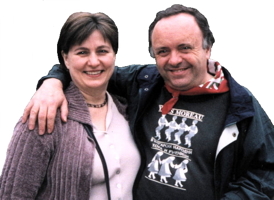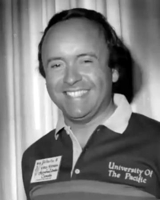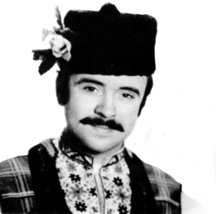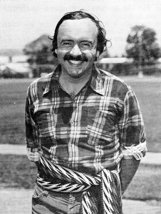|
Yves Moreau and France Bourque-Moreau
|
|
CLICK AN IMAGE FOR LARGER VIEW
Yves Moreau was born in Montréal, Québec. He was twelve years old when he was first introduced to international folk dancing as a member of a Boy Scout Troup. He quickly became fascinated with Balkan music and dance through privileged contacts with such knowledgeable folklorists as Dennis Boxell, Michel Cartier, and Dick Crum. After finishing high school, he spent the summer of 1966 travelling throughout Europe and ended up taking the Orient Express train from Paris, France, to Sofia, Bulgaria. He attended the big folklore gathering in Haskovo, Thrace, and there met Filip Kutev, Stojan Djudjev, Rajna, Katzarova, Maria Veleva, and others of the "Who's who" in Bulgarian folklore. By the time Yves (pronounced EEV) met Pece Atanasovski in Skopje, he was "hooked."
He htraveled to Bulgaria almost annually between 1966 and 1986 to research dance and to record music in all regions of the country. He also lectured and conducted workshops throughout North America as well as on numerous occasions in Australia, Austria, Belgium, France, Germany, Hong Kong, Italy, Japan, Mexico, Netherlands, Norway, Slovenia, Sweden, Switzerland, Taiwan, and New Zealand.
Between 1960 and 1965, Yves danced with several recreational dance groups in the Montréal area, including the Feux-Follets, a group directed by Michel Cartier, and Slavjan, directed by Dennis Boxell who at the time, was a student at McGill University. It is with Slavjan that Yves developed a particular interest in Balkan folklore and culture.
In 1965 and 1966, Yves was very active within the Serbian community of Montréal and was leader of the performing group. He also was a member of the Serbian Choir at Holy Trinity Serbian Church in Montréal.
In 1966, Yves traveled for the first time to Bulgaria. He spent almost six months there, traveling around the country and meeting various folklorists. His association with Dennis Boxell brought him to Seattle in 1967, where he spent a year co-directing the KOLEDA ensemble. In the summer of 1967, he assisted Dennis with his teaching at the Stockton Folk Dance Camp in Stockton, California. It is there that he met Ivan "John" Filcich, who invited him as guest teacher to the 1967 San Francisco Kolo Festival, where Yves made his first appearance as a Balkan specialist.
In 1968, Yves taught in several west coast cities and with the AMAN Folk Ensemble in Los Angeles, California. In 1968, Yves introduced the famous Dobrudžanska Rŭka, a Bulgarian women's dance that he had learned from Camile Brochu. This dance has been taught and re-taught in so many different ways that Yves called it his "ill-fated" dance, although he was not bitter about it. Yves said it is a highly stylized dance, geared to performing groups, and the Dobrudžan style is quite hard to grasp.
In 1969, having received a scholarship from the Bulgarian government, Yves spent a full year in Bulgaria. He was a special guest of the Bulgarian Committee for Friendship and Cultural Relations with Foreign Countries. The Committee for Culture in Sofia tailored a special program for him to travel throughout Bulgaria and spent many weeks in each region of the country learning various regional dance styles and making tapes and films.
1970 and 1971 marked a long tour across the United States and Canada for Yves. He also was guest teacher at such folk dance camps as Stockton Folk Dance Camp, San Diego State University Folk Dance Conference, Mendocino Folklore Camp, and Maine Dance Camp. In 1971, he choreographed a special suite of Dobrudžan dances for the Duquesne University Tamburitzans, which was presented in their North American tours and their appearance in France.
In 1971 and 1972, Yves was coordinator of folk dance activities for the City of Montréal Parks and Recreation Department as well as workshop coordinator for the Québec folk Dance Federation. He was guest speaker at the Dance Canada conference in Edmonton and the CAPHER (Canadian Association for Health, Physical Education and Recreation) conference in Saskatoon. Yves produced several radio broadcasts on international folk dance for the CBC (Canadian Broadcasting Corporation) Fench network.
In 1972, Yves received a grant from the Canadian Council to do research in the Bulgarian-Macedonian communities in Canada.
From 1972 to 1988 he directed Les Gens de Mon Pays, a Montréal-based amateur folk ensemble specializing in Bulgarian and French-Canadian folklore, which toured widely in North America and represented Canada at several international folk festivals in the United States, France, Greece, Italy, and Bulgaria. Yves also choreographed several stage suites of Bulgarian and French-Canadian material for various professional and amateur performing groups in North America, Australia, and New Zealand. In 1992, Yves was appointed artistic associate of the AMAN Folk Ensemble, a professional dance company based in Los Angeles.
From 1975 to 1985, Yves was special projects coordinator at the Canadian Folk Arts Council and is doing similar work with Folklore Canada International, a private organization that coordinates cultural exchange programs and produces several international folk festivals in Canada. After 1986, he was the coordinator of the annual Heritage International folklore workshop.
In 1980, Bulgaria awarded him with the Order of Kiril and Metodi (1st degree) for his work in popularizing Bulgarian folk culture in North America>.
From 1986 to 2000, Yves was the coordinator of the Canadian Folk Arts Council's annual Heritage International folklore workshop in Lachine, Québec, and Cornwall (Ontario).
In 1998, Yves was appointed to the Board of Directors of the EEFC (East European Folklife Center), which organizes the annual Balkan Music and Dance Camps in the United States.
In 2006, Yves was the recipient of the Preserving Our Legacy award by the National Folk Organization U.S.A. (NFO) for a Lifetime of Work and Achievement in Folk Dance and Folk Arts.
In the summer of 2008, Yves celebrated his 60th birthday and 40 years of teaching Bulgarian Folk Dances and received the Presidential Medal and a letter of congratulations from Bulgarian president Georgi Paranov.
Yves, who spoke and wrote Bulgarian fluently, was a regular contributor to various folk music and folklore programs for Canadian radio and television and presented several papers at various conferences on ethnomusicology and folklore in America, Asia, and Bulgaria. In 1980, Bulgaria awarded him with the Order of Kiril and Metodi (1st degree) for his work popularizing Bulgarian folk culture in North America.
Almost annually until 1985, Yves returned to Bulgaria to collect dances and music. He taught mostly non-choreographed village material that he collected during his many field trips. His teaching method was clear and thorough yet relaxed. A special emphasis was put on regional styles and background information. Above all, Yves wanted to share his love for traditional folklore and music and communicate the fun of dancing. Yves also introduced and taught folk dances of other Balkan countries as well as dances from Brittany (France) and his native Québec.
While in Bulgaria in 1969, Yves supervised the production of a very popular long-play (LP) record with twelve new Bulgarian dances that was pressed by the state firm, Balkanton. He supervised more recordings of Bulgarian dances together on the Bulgarian BMA, GEGA, Worldtone, and XOPO labels.
Yves lived in Montréal and was recognized as one of North America's foremost exponents of Bulgarian dance and folklore.
Yves produced five DVDs and matching audio compact discs (CDs) of his repertoire and also released three CDs with some of his Bulgarian village recordings on the BMA label. He produced a two-CD collection of tunes by the legendary Bulgarian accordionist Boris Karlov and prepared a CD compilation dedicated to the famous Thracian clarinetist Georgi Koev.
 France Bourque-Moreau has been active in Canada and abroad teaching folk dances for children and conducting special seminars to train school teachers in this field for more than twenty-five years.
France Bourque-Moreau has been active in Canada and abroad teaching folk dances for children and conducting special seminars to train school teachers in this field for more than twenty-five years.
Her current repertoire includes hundreds of dances and singing/games from all parts of the world especially designed and adapted to various age and experience levels. France also puts emphasis on the French and French-Canadian repertoire, which is widely used in the Canadian school curriculum.
She has been a regular consultant to the Montréal School Board and has helped in the production of two long play records containing French-Canadian songs and dances as well as a similar repertoire representative of the various ethnocultural groups in Montréal. This material is used in the Montréal School Board music and dance program at the elementary school level.
France is the author of Je Danse mon Enfance (I Dance my Childhood) published in 1979 by FLDQ in Montréal and now in its fifth printing. The book contains some 80 dances as well as useful tips on teaching, with emphasis on rhythms, formations, cultural background and psycho-motricity. The book is also approved by the Québec Board of Education. In 1983, she co-authored, with Michel Landry, La Danse d'Inspiration Traditionnelle au Primaire, which suggests a pedagogical approach to teaching folk dance in elementary schools and groups the dances in relationship to holidays, rituals and trade guilds. It also looks at creative variations of traditional dances.
France is a founding member of Dance and the Child Int'l, chairperson of Danse-Education-Folklore du Québec, a provincial organization that regroups educators using folk dancing in schools. DEFQ was responsible for setting up a special children's folklore workshop program, Les Enfants Autour du Monde, first as part of the Drummondville World Folklore Festival and now held annually in Lachine, near Montréal. She has been active in the ORFF music education movement and was President of the Québec Chapter of Orff Music for Children Canada and former secretary on the national executive. She has conducted lectures and courses across North America, Western Europe, Australia, and Japan. She also researched and notated several French-Canadian dances of the Saguenay region that were published in Danses et costumes régionaux au Québec (FLDQ, 1977).
For fifteen years she performed with the folkdance ensemble Les Gens de Mon Pays with whom she toured Europe and North America. In the performing field, France has choregraphed French-Canadian dances for Les Gens de Mon Pays and many other performing groups in Canada and abroad: Les Réveilloneux (Fredericton, New Brunswick), Les Blés d'Or (St.Paul, Alberta), Komenka (New Orleans, Loisiana), Khadra (San Francisco, California), AMAN Folk Ensemble (Los Angeles, California), Carol Maddocks Dancers (Sydney, Australia), and Folkloristich Danstheater (Amsterdam, Netherlands).
In the summer of 1984 and 1988, she taught French-Canadian folk dances at the annual Folklories (gathering of French<> choral groups) in France. In October 1989 she returned to Australia as a guest specialist under the auspices of the Australian Association for Dance Education (now Ausdance). She has made special presentations on folk arts programs for children during CIOFF International folklore festivals and conferences including Orlando and Milwaukee (United States), Zielona Gora (Poland), Rättvik (Sweden) and Ilan (Taiwan). In 1998 she was part of the Canadian official delegation to the Unesco Cultural summit held in Stockholm, Sweden.
France has been vice-president of the Conseil québécois du patrimoine vivant (Québec Living Heritage Council) and is on the Board of la Sociíté du patrimoine d'expression du Québec (SPEQ). She is also a regular lecturer for several Elderhostel programs in Montréal.
Her new audio CD and companion book, Danse, mon coeur danse!, featuring French-Canadian dances, rounds and songs for elementary and pre-school children was released in November 1999.
Yves and France were married on July 16, 1977. The couple lived in Montréal, Québec, with their three children.
Yves Moreau passed away on September 8, 2023 of primary biliary cholangitis (PBC).
Dances Yves taught include
 A Deux Tempss,
Abdala,
An Dro,
An Dro Retourné,
Arapojna,
Arnautsko horo,
Avant-deux de Travers,
Bačkovsko horo,
Bal des Montagnes,
Baldâzka,
Bannielou Lambaol,
Barnenska Tropanka,
Bâtutâ,
Bâtutâ Valea Siretului,
Bavno horo,
Bičak,
Bistrica Kopanica,
Brâsni Cârvul,
Bregovsko horo,
Bučimiš,
Čekurjankino horo,
Čepelarska Rŭčenica,
Čerkezko horo,
Čestata,
Četvorno horo,
Četvorno Ūopsko horo,
Chilili,
Coconeasa,
Cveta Moma,
Dalgopolska rŭčenica,
Dans Leon,
Dans Plinn,
Danse Fisel,
Delčevsko horo,
Deninka,
Denjovo horo,
Deux Lignes du Carré Dominion,
Devojko Mâri Hubava,
Dimitrija,
Divotinsko,
Dobra Nevesto,
Dobro Ljo,
Dobrudžanska Pandela,
Dobrudžanska Rŭka,
Dobrudžanski Buenek,
Dobrudžanski rŭčenik,
Dospatsko horo,
Dramskoto,
Drianovaska rŭčenica,
Drijanovska rŭčenica II,
Duck Dance (Québec),
Dujni Ranke,
Dva Pâti Nadjašno,
Dvašti Trišti,
Džangurica,
Eleno Mome,
Elenska râčenica,
Elinpelinski četvorno,
Enelieio,
Eski,
Farkas Játék,
Floricica,
Gagaužko horo,
Galaona,
Gavotte d'Honneur,
Gergjovdensko horo,
Gilgodenn,
Gjuševska rŭčenica,
Glava li ta Boli,
Glavinsko četvorno,
Gnome Dance,
Graovsko,
Grŭnčarsko horo,
Hajde Kalino,
Hanter Dro,
Harmanlijska rŭčenica,
Hopp mor Annika,
Hora de la Vrav,
Idam ne Idam,
Indijski čoček,
Izručanka,
Jambolski Čapraz,
Jambolsko pajduško horo,
Jambolsko râčenica,
Jove malaj mome,
Kamašica,
Kamenopolsko,
Kamišica,
Kapetan Vojvoda,
Karamfil,
Kardamski opas,
Kardamski Zborenka,
Kjustendilska rŭčenica,
Koga me Mama Rodila,
Kojčovata,
Kokiče,
Kolino horo,
Koljovo horo,
Komarevsko horo,
Kotlenska rŭčenica,
Kouri Dance,
Krivata,
Krivo Ihtimansko horo,
Krivo Panagjursko,
Krivo Petričko horo,
Krivo Plovdivsko horo,
Krivo Sadovsko horo,
Krusarski opas,
Kučinata,
Kukuvička,
Kulska Šira,
Kulsko horo,
La Bastringue,
La Bella Lavendarina,
La Belle Catherine,
La Bastringue,
La Contredanse,
Le Cotilion,
La Laine des Moutons,
La Miranda,
La Noce des Oiseaux,
La Veille Bastringue,
Lalica,
Laridé de la Coâte,
Laridé de Locmariaquer,
Lazarska Rŭčenica,
Le Bal des Montagnes,
Le Capitaine Trompeur,
Le Cotillion de Baie Ste-Catherine,
Le Capitaine Trompeur,
Le Cotillion,
Le Cotillion de Baie Ste-Catherine,
Le Danse des Mouchoirs,
Le Laridé,
Le Noce des Oiseaux,
Le Panier,
Le Petite Boiteuse,
Le "Rapide,"
Les Mains Blanches,
Les P'tits Chars,
Les Saluts,
Lijano Mome,
Lilie Vendelbo,
Little Horse,
Ljaskovsko horo,
Ljavata,
Lomskata,
Los Machetes,
Lyasa,
Makedonsko Narodno,
Malhao Bourée,
Mali Izvorski opas,
Mališevsko horo,
Mari Marijko,
Maričensko horo,
Maričensko pravo horo,
Megdansko horo,
Mŭžki Buenek,
Melniško horo,
Minka,
Momačka šetnja,
Momino horo,
Na Pŭt,
Narodno,
Neda Voda Nalivala,
Nešo,
Nestinarsko horo,
Nevesto Cârven Trendafil,
Nevrokopsko horo,
Novolesko horo,
Novoselsko horo,
O Mouzikos,
Oj Dimitro Le,
Opas,
Osmica,
Padna Mogla,
Panagjursko horo,
Pandalaš (Kucata),
Pasarelska,
Perniška kopanica,
Petite Chaîne de Montmagny,
Pinosavka,
Pletenica,
Plevensko dajčovo horo,
Polka Piquée,
Pomaško širto,
Porunceasca,
Povlekana,
Pravo Čapraz,
Pravo Čepelarsko horo,
Pravo Devojko Mari Hubava,
Pravo horo,
Pravo Kapansko horo,
Pravo Petersko horo,
Pravo Rhodopsko horo,
Pravo Šopsko horo,
Pravo Trakijsko horo,
Preskačanka,
Proletno horo,
Quadrille de Saint-Basile,
Raca Plava,
Radomirsko horo,
Radomirska Lesa,
Radomirsko horo,
Rano e Radka Ranila,
Razložko horo,
Rusensko horo,
Sâbrale sa se Sâbrale,
Sadi Moma,
Salajan,
Sandansko horo,
Satovčensko horo,
Scottish d'Auvergne,
Sedi Donka (Zapadna Trakija),
Sej sej bob,
Set De Fortierville,
Severnjaška Rŭčenica,
Silistrenska tropanka,
Silistrenski opas,
Šira,
Site Momi,
Sitna Baluca,
Sitna Zborenka,
Sitno Mališevsko,
Sitno Žensko horo,
Skopska Zaramo (Zajko Kokorajko),
Skudrinka (Džangurica),
Slivensko pajduško horo,
Slivenska račenica,
Šopski Lazarki,
Šopsko za Pojas,
Soldier's Joy,
Soroc,
Srebranski Danec,
Stani Sterko,
Starčeska rŭčenica,
Staro Bansko horo,
Staro Kulsko horo,
Staro Pomaško,
Staro Zagorsko horo,
Stiga mi se momne le,
Strandžansko pajduško,
Sŭbrali sa se sŭbrali,
Svadbarska răčenica,
Tŭkanata,
Talima,
Tervelska rŭka,
Tervelska tropanka,
Trakijska rŭčenica,
Trite Pŭti,
Trite Pŭti ot Strandež,
Trite Pŭti ot Sliven,
Tropanka,
Tsonkovo horo,
Valćidolska Kucata,
Valle Pogonište,
Valse de l'Amitié,
Valse Lancier,
Varnenska Kjuček,
Varnenska tropanka,
Varnensko horo,
Verčeraj Sino,
Vidinsko horo,
Vielle la Bastringue,
Vodeno horo,
Vlaško horo,
Vŭlčidolska Kucata,
Wassouma,
Zavedi me Jalino,
Zborenka,
Ženska za rŭka,
Ženski Čapraz,
Žensko Kapansko horo,
Žensko Svatbarsko horo,
Žensko za raka,
Žikino horo,
and
Žvansko oro.
A Deux Tempss,
Abdala,
An Dro,
An Dro Retourné,
Arapojna,
Arnautsko horo,
Avant-deux de Travers,
Bačkovsko horo,
Bal des Montagnes,
Baldâzka,
Bannielou Lambaol,
Barnenska Tropanka,
Bâtutâ,
Bâtutâ Valea Siretului,
Bavno horo,
Bičak,
Bistrica Kopanica,
Brâsni Cârvul,
Bregovsko horo,
Bučimiš,
Čekurjankino horo,
Čepelarska Rŭčenica,
Čerkezko horo,
Čestata,
Četvorno horo,
Četvorno Ūopsko horo,
Chilili,
Coconeasa,
Cveta Moma,
Dalgopolska rŭčenica,
Dans Leon,
Dans Plinn,
Danse Fisel,
Delčevsko horo,
Deninka,
Denjovo horo,
Deux Lignes du Carré Dominion,
Devojko Mâri Hubava,
Dimitrija,
Divotinsko,
Dobra Nevesto,
Dobro Ljo,
Dobrudžanska Pandela,
Dobrudžanska Rŭka,
Dobrudžanski Buenek,
Dobrudžanski rŭčenik,
Dospatsko horo,
Dramskoto,
Drianovaska rŭčenica,
Drijanovska rŭčenica II,
Duck Dance (Québec),
Dujni Ranke,
Dva Pâti Nadjašno,
Dvašti Trišti,
Džangurica,
Eleno Mome,
Elenska râčenica,
Elinpelinski četvorno,
Enelieio,
Eski,
Farkas Játék,
Floricica,
Gagaužko horo,
Galaona,
Gavotte d'Honneur,
Gergjovdensko horo,
Gilgodenn,
Gjuševska rŭčenica,
Glava li ta Boli,
Glavinsko četvorno,
Gnome Dance,
Graovsko,
Grŭnčarsko horo,
Hajde Kalino,
Hanter Dro,
Harmanlijska rŭčenica,
Hopp mor Annika,
Hora de la Vrav,
Idam ne Idam,
Indijski čoček,
Izručanka,
Jambolski Čapraz,
Jambolsko pajduško horo,
Jambolsko râčenica,
Jove malaj mome,
Kamašica,
Kamenopolsko,
Kamišica,
Kapetan Vojvoda,
Karamfil,
Kardamski opas,
Kardamski Zborenka,
Kjustendilska rŭčenica,
Koga me Mama Rodila,
Kojčovata,
Kokiče,
Kolino horo,
Koljovo horo,
Komarevsko horo,
Kotlenska rŭčenica,
Kouri Dance,
Krivata,
Krivo Ihtimansko horo,
Krivo Panagjursko,
Krivo Petričko horo,
Krivo Plovdivsko horo,
Krivo Sadovsko horo,
Krusarski opas,
Kučinata,
Kukuvička,
Kulska Šira,
Kulsko horo,
La Bastringue,
La Bella Lavendarina,
La Belle Catherine,
La Bastringue,
La Contredanse,
Le Cotilion,
La Laine des Moutons,
La Miranda,
La Noce des Oiseaux,
La Veille Bastringue,
Lalica,
Laridé de la Coâte,
Laridé de Locmariaquer,
Lazarska Rŭčenica,
Le Bal des Montagnes,
Le Capitaine Trompeur,
Le Cotillion de Baie Ste-Catherine,
Le Capitaine Trompeur,
Le Cotillion,
Le Cotillion de Baie Ste-Catherine,
Le Danse des Mouchoirs,
Le Laridé,
Le Noce des Oiseaux,
Le Panier,
Le Petite Boiteuse,
Le "Rapide,"
Les Mains Blanches,
Les P'tits Chars,
Les Saluts,
Lijano Mome,
Lilie Vendelbo,
Little Horse,
Ljaskovsko horo,
Ljavata,
Lomskata,
Los Machetes,
Lyasa,
Makedonsko Narodno,
Malhao Bourée,
Mali Izvorski opas,
Mališevsko horo,
Mari Marijko,
Maričensko horo,
Maričensko pravo horo,
Megdansko horo,
Mŭžki Buenek,
Melniško horo,
Minka,
Momačka šetnja,
Momino horo,
Na Pŭt,
Narodno,
Neda Voda Nalivala,
Nešo,
Nestinarsko horo,
Nevesto Cârven Trendafil,
Nevrokopsko horo,
Novolesko horo,
Novoselsko horo,
O Mouzikos,
Oj Dimitro Le,
Opas,
Osmica,
Padna Mogla,
Panagjursko horo,
Pandalaš (Kucata),
Pasarelska,
Perniška kopanica,
Petite Chaîne de Montmagny,
Pinosavka,
Pletenica,
Plevensko dajčovo horo,
Polka Piquée,
Pomaško širto,
Porunceasca,
Povlekana,
Pravo Čapraz,
Pravo Čepelarsko horo,
Pravo Devojko Mari Hubava,
Pravo horo,
Pravo Kapansko horo,
Pravo Petersko horo,
Pravo Rhodopsko horo,
Pravo Šopsko horo,
Pravo Trakijsko horo,
Preskačanka,
Proletno horo,
Quadrille de Saint-Basile,
Raca Plava,
Radomirsko horo,
Radomirska Lesa,
Radomirsko horo,
Rano e Radka Ranila,
Razložko horo,
Rusensko horo,
Sâbrale sa se Sâbrale,
Sadi Moma,
Salajan,
Sandansko horo,
Satovčensko horo,
Scottish d'Auvergne,
Sedi Donka (Zapadna Trakija),
Sej sej bob,
Set De Fortierville,
Severnjaška Rŭčenica,
Silistrenska tropanka,
Silistrenski opas,
Šira,
Site Momi,
Sitna Baluca,
Sitna Zborenka,
Sitno Mališevsko,
Sitno Žensko horo,
Skopska Zaramo (Zajko Kokorajko),
Skudrinka (Džangurica),
Slivensko pajduško horo,
Slivenska račenica,
Šopski Lazarki,
Šopsko za Pojas,
Soldier's Joy,
Soroc,
Srebranski Danec,
Stani Sterko,
Starčeska rŭčenica,
Staro Bansko horo,
Staro Kulsko horo,
Staro Pomaško,
Staro Zagorsko horo,
Stiga mi se momne le,
Strandžansko pajduško,
Sŭbrali sa se sŭbrali,
Svadbarska răčenica,
Tŭkanata,
Talima,
Tervelska rŭka,
Tervelska tropanka,
Trakijska rŭčenica,
Trite Pŭti,
Trite Pŭti ot Strandež,
Trite Pŭti ot Sliven,
Tropanka,
Tsonkovo horo,
Valćidolska Kucata,
Valle Pogonište,
Valse de l'Amitié,
Valse Lancier,
Varnenska Kjuček,
Varnenska tropanka,
Varnensko horo,
Verčeraj Sino,
Vidinsko horo,
Vielle la Bastringue,
Vodeno horo,
Vlaško horo,
Vŭlčidolska Kucata,
Wassouma,
Zavedi me Jalino,
Zborenka,
Ženska za rŭka,
Ženski Čapraz,
Žensko Kapansko horo,
Žensko Svatbarsko horo,
Žensko za raka,
Žikino horo,
and
Žvansko oro.
Includes biographical information from Murray Spiegel.

